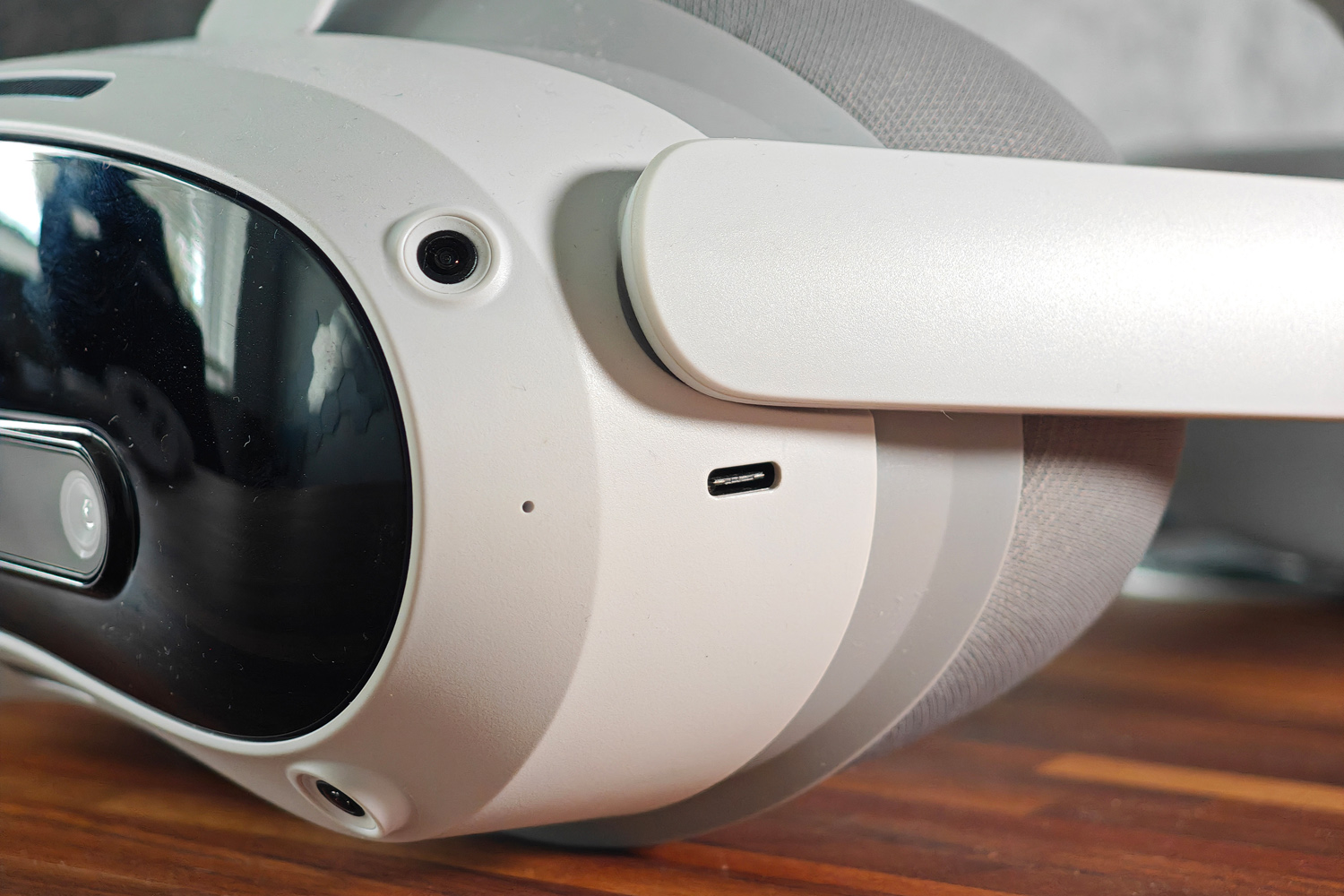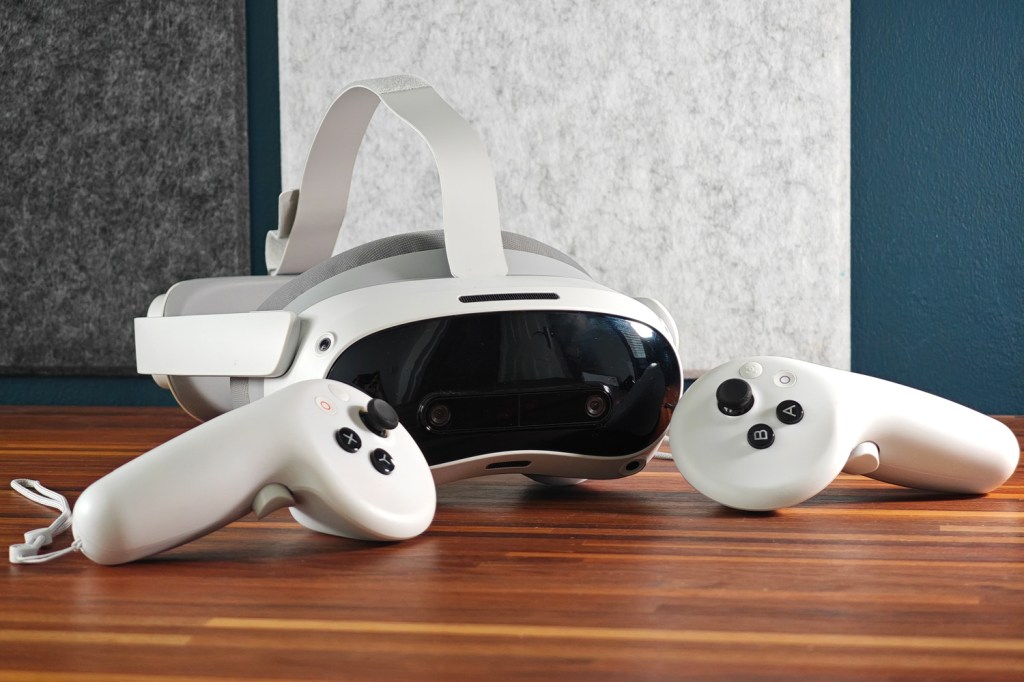Introduction
Standalone VR has been Meta’s playground for a while now, at least here in the West. It’s a different story in China, where TikTok owner Bytedance rules the roost with its Pico range – a range that has just been overhauled with mixed reality in mind. The Pico 4 Ultra builds on the regular Pico 4 with much-improved passthrough, refined controllers, and an official full-body tracking add-on that promises much more immersion in games and VR experiences.
More memory, a bigger battery and a refined interface make it look like a big step up on paper. The spec sheet puts the Meta Quest 3 to shame, as did the competitive £529 launch price – or at least it was competitive, before the Quest 3S was officially revealed and Meta shook up its pricing structure. With Meta snaring VR software like they’re Pokemon, can Pico still compete?
Design & build: familiar feeling

Aside from the pair of eye-like 32MP colour passthrough cameras up front, the Pico 4 Ultra is pretty much identical to the standard version. The grey-on white colour scheme returns, with an opaque black glass visor that arguably has more in common with Apple Vision Pro than any current Meta Quest. Just without the external screen.
As before, Pico has kept the headset dimensions in check by using pancake lenses, which take up less room than fresnel lenses. Motorised IPD adjustment is great to see, too – there’s far more control than you’ll get with a Meta Quest 3. There’s no face or eye tracking here, so you don’t get goodies like foveated rendering as you do with PS VR 2 and the much pricier HTC Vive Focus Vision.
Four inside-out cameras are still subtly track your movement, the power button is still found on the right side, and the USB-C port on the left. I constantly forgot the volume controls are built into the headband’s top edge, just like last time. There’s still no 3.5mm port, so Bluetooth or USB-C earphones are the way forward for immersive audio – though the built-in speakers do a decent job with positional audio.
The headband (part-plastic, part-fabric) doesn’t detach, but I had no complaints about the fit; an adjustment dial at the rear let me get a secure yet comfortable placement on my face, with great weight distribution preventing the headset from drooping. At 580g all-in it’s a fair bit heavier than a Quest 3, which I definitely clocked after a few hours of use.
The thickly padded face mask is held on with strong magnets, so can be easily popped off for cleaning or fitting the included glasses spacer. It blocks out light really well, too.
Controllers: leg it


The Pico 4 Ultra’s controllers look quite different from the ones bundled with the regular headset; they’ve ditched the bulky tracking rings, making them an almost exact match for the Meta Quest 3’s. The only difference is the Pico has an extra button on each side. One opens the menu, while the other is dedicated to taking screenshots and screen recordings.
A joystick, trigger, grab button and two face buttons are pretty much the standard for modern VR, and all are suitably clicky. It can detect finger positioning and had zero issues with tracking or latency during my testing. I didn’t bash them into each other nearly as often as I did on the regular Pico 4, which was a bonus.
They still use disposable AA batteries rather than any kind of built-in rechargeable one, but swapping them out is the matter of a few seconds. The pre-fitted wrist straps are a must-use for any frantic action, lest you put one through a window or your TV by accident.
While they’re not included as standard, Pico did bundle its full-body motion trackers in for anyone that pre-ordered a Pico 4 Ultra. They usually cost £79 for the pair. The ankle-worn trackers pair quickly and let games keep score of where your feet are, which really adds to the immersion in apps like VRchat and games that focus on fitness. Combined with the head and arm tracking they do a great job of working out where your body is at any given moment. If your favourite VR titles support them, they’re well worth the extra.
Interface: seethrough star
Two 32MP colour cameras and a depth sensor make this headset far better at overlaying the outside world than the regular Pico 4, which made do with a single 16MP lens and zero impression of depth. The clarity is that much higher I could use my smartphone without taking the headset off, and there was much less distortion at the edges of the lenses. There’s still a bit of graininess, but nowhere near as much as before.
Those cameras can be used to take spatial photos and videos, which I think is more neat addition than must-have feature. You’re even less likely to wear one of these away from home than you are an Vision Pro, and quality isn’t a patch on Apple’s much pricier headset.
Pico has overhauled the UI to make the most of passthrough, with a shortcut on the main menu to toggle between mixed and virtual reality. You can drag and drop windows around you now, in a more freeform way than Meta’s more rigid carousel layout. I also like that you can generate new virtual backgrounds using AI, in case you fancy a change of scenery.
Getting set up is far quicker than a recent Meta Quest, as Pico doesn’t overload you with explanations and tutorials. You’ll still need to create an account to buy games and apps from the Pico Store, but it’s the work of a few minutes. The shortcut bar near the bottom of your vision is still conveniently sized for zapping between apps without perfect aim; Meta’s smaller UI elements are just that little bit more fiddly, in my opinion.
Games & experiences: growing, but is that enough?
256GB is a decent amount of storage for apps, games and locally-stored videos. You’ve got more chance of filling it up compared to when I reviewed the Pico 4 back in 2022, as the store’s offering has grown considerably.
That said, Rival Meta is spending big to get exclusive access to brand-name games like Assassin’s Creed and Batman Arkham Shadow, while VR classics like Beat Sabre and Super Hot are also MIA here. Pico isn’t crazy far behind, with recognisable titles like Bulletstorm VR and Vampire: The Masquerade – Justice on board, but you’re definitely locking yourself out of certain big hitters buy buying Pico over a Quest.
It does have Pico Connect, for a wired or wireless connection to a computer for PCVR gaming, so that could be a good way to fill the gap. It worked as advertised for me over USB-C, with a simple setup through Steam VR and smooth frame delivery.
The Ultra doesn’t mess about on the hardware front, with a Qualcomm Snapdragon XR2 Gen 2 and 12GB of RAM giving it a real leg up on Pico 4. Render resolution is also a little higher, despite using the same pancake lenses. That means an identical 105-degree field of view, which is a little narrower than Quest 3, but ahead of Quest 3S.
Image quality is top notch for the money, with impressively deep blacks and plenty of contrast given the LCD panel tech being used. Everything felt smoother here than on a Quest 3, with fewer aliased edges in games. Arizona Sunshine 2 was a blast, with brilliantly atmospheric areas packed with plenty of detail, and little in the way of dropped frames.
Battery life: long enough


Pico found room inside the Ultra for a 5700mAh battery, which is slightly larger than the regular Pico 4’s 5300mAh unit. It’s enough that even with more liberal use of passthrough than before, both headsets last about as long as each other in typical use. That was between one and four hours in my testing, depending on whether I was playing 3D games with full body tracking, or kicking back with a VR video.
This is a bit better than a Quest 3 can manage, and longer than I like to spend in VR in one go anyway. Power saving mode drops the image quality to extend the lifespan a little, but I’d rather just play tethered to a power socket instead.
It’s here where the Ultra shows real gains over the Pico 4. It can charge at 45W, which is more than double what the vanilla version can manage. With a beefy enough power brick I could play and still build up power reserves for when it came time to disconnect from the mains. Pico doesn’t include one in the box, though.
The controllers will go for a lot longer, naturally, and as they swallow AA batteries it’s easy enough to keep them topped up – as long as you have spares lying around. The motion trackers last for up to 25 hours each, and charge over USB-C. They auto power down once you stop wearing ’em, too.
Pico 4 Ultra verdict


Compared to the regular Pico 4, the Ultra is a serious upgrade. Much-improved passthrough cameras open up a world of mixed reality possibilities, and the interface has been streamlined with that in mind. There’s plenty of power here for gorgeous VR experiences, and no shortage of storage. The full body trackers are a must-buy if you’re into fitness apps or VR chat.
As much as software support has improved, though, big rival Meta has still got the lion’s share of exclusives and big-name releases. The Pico 4 Ultra also arrives right as the Quest 3 got a considerable price cut, meaning it doesn’t even have value on its side any more. That makes it more of a left-field choice than ever, as long as you live somewhere the Quest 3 is sold.
If not, however – or you’d rather not line Zuckerberg’s pockets any further – it’s still a well-equipped standalone headset.
Pico 4 Ultra technical specifications
| Resolution | 2160×2160 per eye, 90Hz |
| Optics | 105° pancake lens w/ 20.6 PPD, 62-72mm inter-pupillary distance adjustment |
| CPU | Qualcomm Snapdragon XR2 Gen 2 |
| Memory | 12GB RAM |
| Storage | 256GB on-board |
| Cameras | 2x 32MP colour passthrough, i-TOF depth sensor, 4x tracking cameras |
| Operating system | Pico OS |
| Connectivity | Wi-Fi, Bluetooth, USB |
| Battery life | 5700mAh (headset), 2xAA (controllers, each) |
| Dimensions | 165×256-310x80mm (allowing for headband adjustment), 580g |





